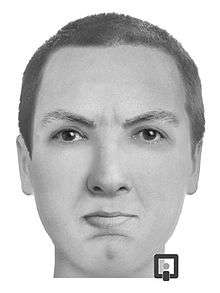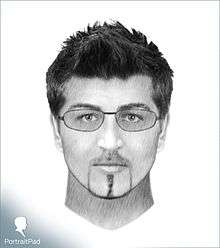Facial composite

A facial composite is a graphical representation of an eyewitness's memory of a face, as recorded by a composite artist. Facial composites are used mainly by police in their investigation of (usually serious) crimes. These images are also used to reconstruct the victim's face in hope of identifying them.
Methods
PhotoFIT generation
Construction of the composite was originally performed by a trained artist, through drawing, sketching, or painting, in consultation with a witness or crime victim. In the 1970s techniques were devised for use by those less artistically skilled, employing interchangeable templates of separate facial features, such as "Photofit" in the UK, Smith & Wesson's "Identi-Kit" in the US and PortraitPad.
In the last two decades, a number of computer based facial composite systems have been introduced; amongst the most widely used systems are SketchCop FACETTE Face Design System Software, "Identi-Kit 2000", FACES, E-FIT and PortraitPad. In the U.S. the FBI maintains that hand-drawing is its preferred method for constructing a facial composite. Many other police agencies, however, use software, since suitable artistic talent is often not available.
Evolutionary systems
Until quite recently, the facial composite systems used by international police forces were exclusively based on a construction methodology in which individual facial features (eyes, nose, mouth, eyebrows, etc.) are selected one at a time from a large database and then electronically 'overlaid' to make the composite image. Such systems are often referred to as feature-based since they essentially rely on the selection of individual features in isolation. However, after a long period of research and development work conducted largely within British Universities, systems based on a rather different principle are finding increasing use by police forces.[1][2][3] These systems may be broadly described as holistic or global in that they primarily attempt to create a likeness to the suspect through an evolutionary mechanism in which a witness's response to groups of complete faces (not just features) converges towards an increasingly accurate image. Three such systems have come from academic beginnings, EFIT-V from the University of Kent;[4] EvoFIT (http://www.EvoFIT.co.uk) from the University of Stirling, the University of Central Lancashire (UCLan) and the University of Winchester;[5] and ID from the University of Cape Town, South Africa.
Research
A general review of research into the evaluation of mechanical template techniques may be found in Davies and Valentine (2006).[6] A review of research into more modern 'feature' and 'recognition' systems, and into methods for improving the effectiveness of composites, may be found in Frowd et al. (2008)[7] and (2009).[8]


The systems used in the UK have been subjected to a number of academic studies. These have typically shown that E-FIT and PRO-fit produce composites that are correctly named, either immediately or a few hours after construction, about 20% of the time (see Brace et al. (2000),[9] Bruce et al. (2002),[10] Davies et al. (2000)[11] and Frowd et al. (2005)[12]). When witnesses in these studies are required to wait two days before constructing a composite, which matches real use more closely, naming falls to a few percent at best (e.g. Frowd et al. [2005][13] and [2007][14][15]). The reason for the low level of naming from these systems appears to be that witnesses are unable to accurately construct the internal features of the face after long delays, the region that is important for recognition by another person later (Frowd et al. [2007][16]).
Evolutionary systems show a marked improvement in accuracy. In academic trials, research on a fairly-recent version of the EvoFIT system has shown correct naming levels of about 30% after a 2-day delay (see Frowd et al., 2010).[17] Using more-recent construction techniques, the performance increased to 45% correct naming (Frowd et al., 2012).[18] Using the very latest system, interview and enhancement techniques, naming of an EvoFIT composite is 74% correct (Frowd et al., 2013).[5] Appropriately, the system does appear to behave more like a face recognition than a face recall system (Frowd et al., 2011)[19] Accompanying the development of EvoFIT have been new approaches in the type of interview administered to eyewitnesses prior to face construction (e.g. Frowd et al., 2012).[20] Similarly in extensive field use EFIT-V has shown a 40% naming rate over an 18-month period with 1000 interviews.[21] The EvoFIT system has been similarly evaluated in formal police field-trials.[22] These evaluations have reported a much higher naming rate for EvoFIT composites but, using the latest interview techniques, a suspect arrest rate of 60%. This latest police field trial has also indicated that an EvoFIT directly leads to the arrest of a suspect and then a conviction in 29% of cases.[23] There have been many notable successes - for example, in this investigation, EvoFIT has directly led to the arrest of a serial rapist.[24]
Usage
While the classic use of the facial composite is the citizen recognizing the face as an acquaintance, there are other ways where a facial composite can prove useful. The facial composite can contribute in law enforcement in a number of ways:
- Identifying the suspect in a wanted poster.
- Additional evidence against a suspect.
- Assisting investigation in checking leads.
- Warning vulnerable population against serial offenders.
Facial composites of various types have been used extensively in those television programs which aim to reconstruct major unsolved crimes with a view to gaining information from the members of the public, such as "America's Most Wanted" in the US and "Crimewatch" in the UK.
Notable cases
These notable cases had facial composites assist in identifying the perpetrator:
- Oklahoma City bomber Timothy McVeigh.
- Niklas Lindgren, also known as "Hagamannen", a serial sexual assaulter in Umeå.
- Baton Rouge serial killer Derrick Todd Lee.
- Manchester serial rapist Asin Javed.[26]
References
- ↑ Frowd, C. D.; Hancock, P. J. B.; Bruce, V.; McIntyre, A.; Pitchford, M.; Atkins, R.; et al. (2010). "Giving crime the 'evo': catching criminals using EvoFIT facial composites". In Howells, G.; Sirlantzis, K.; Stoica, A.; Huntsberger, T.; Arslan, A. T. 2010 IEEE International Conference on Emerging Security Technologies. pp. 36–43. ISBN 978-0-7695-4175-4.
- ↑ Gibson, S. J.; Solomon, C. J.; Maylin, M. I. S.; Clark, C. (2009). "New methodology in facial composite construction: from theory to practice". Int. J.Electronic Security and Digital Forensics. 2 (2): 156–168. doi:10.1504/IJESDF.2009.0249.
- ↑ Solomon, C.; Gibson, S.; Maylin, M. (2009). "A New Computational Methodology for the Construction of Forensic, Facial Composites". Computational Forensics. Springer-Verlag LNCS. pp. 67–77. ISBN 9783540853022.
- ↑ Craig Aaen Stockdale (June 1, 2008). "A (r)evolution in Crime-fighting.". Forensic Magazine.
- 1 2 Frowd, C. D.; Skelton, F.; Hepton, G.; Holden, L.; Minahil, S.; Pitchford, M.; McIntyre, A.; Hancock, P. J. B. (2013). "Whole-face procedures for recovering facial images from memory". Science & Justice. 53 (2): 89–97. doi:10.1016/j.scijus.2012.12.004.
- ↑ Davies, G. M.; Valentine, T. (2006). "Facial composites: Forensic utility and psychological research". In Lindsay, R. C. L.; Ross, D. F.; Read, J. D.; et al. Handbook of Eyewitness Psychology. 2. Mahwah, NJ: Erlbaum. pp. 59–96. ISBN 9780805851526.
- ↑ Frowd, C. D.; Bruce, V.; Hancock, P. J. B. (2008). "Changing the face of criminal identification". The Psychologist. 21 (8): 670–672.
- ↑ Frowd, C. D.; Bruce, V.; Hancock, P. J. B. (2009). "Evolving facial composite systems". Forensic Update. 98: 25–32.
- ↑ Brace, N.; Pike, G.; Kemp, R. (2000). "Investigating E-FIT using famous faces". In Czerederecka, A.; Jaskiewicz-Obydzinska, T.; Wojcikiewicz, J. Forensic Psychology and Law. Krakow Institute of Forensic Research Publishers. pp. 272–276. ISBN 978-0-470-09623-9.
- ↑ Bruce, V.; Ness, H.; Hancock, P. J. B.; Newman, C.; Rarity, J. (2002). "Four heads are better than one: Combining face composites yields improvements in face likeness". Journal of Applied Psychology. 87 (5): 894–902. doi:10.1037/0021-9010.87.5.894.
- ↑ Davies, G. M.; Van Der Willie, P.; Morrison, L. J. (2000). "Facial composite production: A comparison of mechanical and computer driven systems". Journal of Applied Psychology. 85 (1): 119–124. doi:10.1037/0021-9010.85.1.119. PMID 10740962.
- ↑ Frowd, C. D.; Carson, D.; Ness, H.; Richardson, J.; Morrison, L.; McLanaghan, S.; Hancock, P. J. B. (2005). "A forensically valid comparison of facial composite systems". Psychology, Crime & Law. 11 (1): 33–52. doi:10.1080/10683160310001634313.
- ↑ Frowd, C. D.; Carson, D.; Ness, H.; McQuiston, D.; Richardson, J.; Baldwin, H.; Hancock, P. J. B. (2005). "Contemporary composite techniuqes: the impact of a forensically-relevant target delay". Legal and Criminological Psychology. 10 (1): 63–81. doi:10.1348/135532504X15358.
- ↑ Frowd, C. D.; Bruce, V.; Ness, H.; Bowie, L.; Thomson-Bogner, C.; Paterson, J.; McIntyre, A.; Hancock, P. J. B. (2007). "Parallel approaches to composite production". Ergonomics. 50 (4): 562–585. doi:10.1080/00140130601154855.
- ↑ Frowd, C. D.; McQuiston-Surrett, D.; Anandaciva, S.; Ireland, C. E.; Hancock, P. J. B. (2007). "An evaluation of US systems for facial composite production". Ergonomics. 50 (12): 1987–1998. doi:10.1080/00140130701523611.
- ↑ Frowd, C. D.; Bruce, V.; McIntyre, A.; Hancock, P. J. B. (2007). "The relative importance of external and internal features of facial composites". British Journal of Psychology. 98 (1): 61–77. doi:10.1348/000712606X104481.
- ↑ Frowd, C. D.; Pitchford, M.; Bruce, V.; Jackson, S.; Hepton, G.; Greenall, M.; McIntyre, A.; Hancock, P. J. B. (2010). "The psychology of face construction: giving evolution a helping hand". Applied Cognitive Psychology. 25 (2): 195–203. doi:10.1002/acp.1662.
- ↑ Frowd, C. D.; Skelton, F.; Atherton, C.; Pitchford, M.; Hepton, G.; Holden, L.; McIntyre, A.; Hancock, P. J. B. (2012). "Recovering faces from memory: the distracting influence of external facial features". Journal of Experimental Psychology: Applied. 18 (2): 224–238. doi:10.1037/a0027393.
- ↑ Frowd, C. D.; Skelton, F.; Butt, N.; Hassan, A.; Fields, S. (2011). "Familiarity effects in the construction of facial-composite images using modern software systems". Ergonomics. 54 (12): 1147–1158. doi:10.1080/00140139.2011.623328.
- ↑ Frowd, C. D.; Nelson, L.; Skelton, F. C.; Noyce, R.; Atkins, R.; Heard, P.; Morgan, D.; Fields, S.; Henry, J.; McIntyre, A.; Hancock, P. J. B. (2012). "Interviewing techniques for Darwinian facial composite systems". Applied Cognitive Psychology. 26 (4): 576–584. doi:10.1002/acp.2829.
- ↑ Solomon, C.; Gibson, S.; Maylin, M. "Generation of Facial Composites for Criminal Investigations". In Rynn, Chris. Craniofacial Identification. Cambridge University Press. pp. 67–77. ISBN 9780521768627.
- ↑ Frowd, C. D.; Hancock, P. J. B.; Bruce, V.; Skelton, F. C.; Atherton, C.; Nelson, L.; et al. (2011). "Catching more offenders with EvoFIT facial composites: lab research and police field trials". Global Journal of Human Social Science. 11 (3): 46–58.
- ↑ Frowd, C. D.; Pitchford, M.; Skelton, F.; Petkovic, A.; Prosser, C.; Coates, B. (2012). "Catching Even More Offenders with EvoFIT Facial Composites". In Stoica, A.; Zarzhitsky, D.; Howells, G.; Frowd, C.; McDonald-Maier, K.; Erdogan, A.; Arslan, T. IEEE Proceedings of 2012 Third International Conference on Emerging Security Technologies. pp. 20–26. doi:10.1109/EST.2012.26.
- ↑ Jaya Narain (27 July 2011). "The changing face of crime: Powerful new Evo-fit technology helps catch rapist". Daily Mail. London.
- ↑ Scroggins, Deborah (March 1, 2005). "The Most Wanted Woman in the World" (Limited access, subscription required). Vogue, reprinted by 'Access My Library'.
- ↑ Narain, Jaya (July 27, 2011). "The changing face of crime: Powerful new Evo-fit technology helps catch rapist". Daily Mail. London.